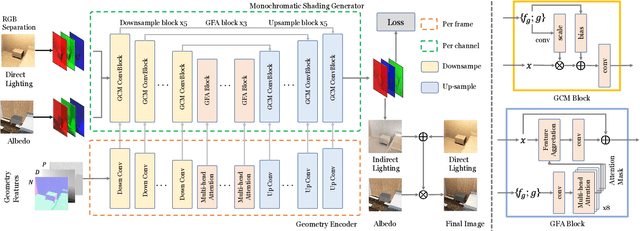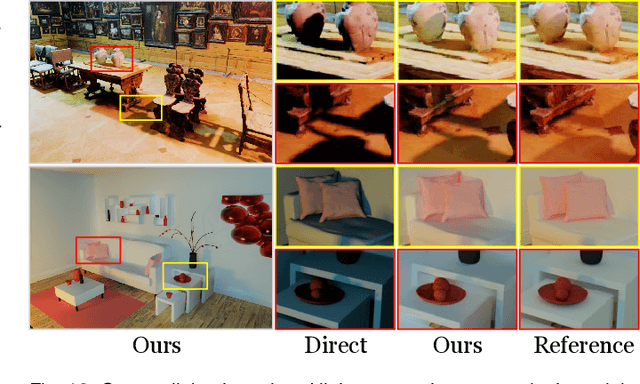Meng Gai
Geometry-Aware Global Feature Aggregation for Real-Time Indirect Illumination
Aug 12, 2025



Abstract:Real-time rendering with global illumination is crucial to afford the user realistic experience in virtual environments. We present a learning-based estimator to predict diffuse indirect illumination in screen space, which then is combined with direct illumination to synthesize globally-illuminated high dynamic range (HDR) results. Our approach tackles the challenges of capturing long-range/long-distance indirect illumination when employing neural networks and is generalized to handle complex lighting and scenarios. From the neural network thinking of the solver to the rendering equation, we present a novel network architecture to predict indirect illumination. Our network is equipped with a modified attention mechanism that aggregates global information guided by spacial geometry features, as well as a monochromatic design that encodes each color channel individually. We conducted extensive evaluations, and the experimental results demonstrate our superiority over previous learning-based techniques. Our approach excels at handling complex lighting such as varying-colored lighting and environment lighting. It can successfully capture distant indirect illumination and simulates the interreflections between textured surfaces well (i.e., color bleeding effects); it can also effectively handle new scenes that are not present in the training dataset.
Visual Acuity Consistent Foveated Rendering towards Retinal Resolution
Mar 30, 2025



Abstract:Prior foveated rendering methods often suffer from a limitation where the shading load escalates with increasing display resolution, leading to decreased efficiency, particularly when dealing with retinal-level resolutions. To tackle this challenge, we begin with the essence of the human visual system (HVS) perception and present visual acuity-consistent foveated rendering (VaFR), aiming to achieve exceptional rendering performance at retinal-level resolutions. Specifically, we propose a method with a novel log-polar mapping function derived from the human visual acuity model, which accommodates the natural bandwidth of the visual system. This mapping function and its associated shading rate guarantee a consistent output of rendering information, regardless of variations in the display resolution of the VR HMD. Consequently, our VaFR outperforms alternative methods, improving rendering speed while preserving perceptual visual quality, particularly when operating at retinal resolutions. We validate our approach using both the rasterization and ray-casting rendering pipelines. We also validate our approach using different binocular rendering strategies for HMD devices. In diverse testing scenarios, our approach delivers better perceptual visual quality than prior foveated rendering while achieving an impressive speedup of 6.5$\times$-9.29$\times$ for deferred rendering of 3D scenarios and an even more powerful speedup of 10.4$\times$-16.4$\times$ for ray-casting at retinal resolution. Additionally, our approach significantly enhances the rendering performance of binocular 8K path tracing, achieving smooth frame rates.
 Add to Chrome
Add to Chrome Add to Firefox
Add to Firefox Add to Edge
Add to Edge